From Mons to Ypres: Irish battalions in the BEF, 1914
Published in Decade of Centenaries, Features, Issue 4 (July/August 2014), Volume 22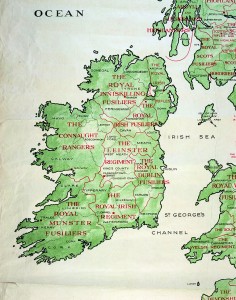
Prior to 1922, eight infantry ‘regiments of the line’ recruited in Ireland. As demonstrated here, each regiment had a specific catchment area. A ninth infantry regiment, the élite Irish Guards, was based in London. Each of these regiments was represented at the costly battles of 1914.
Eight infantry regiments of the British Army recruited in Ireland, each of which maintained a peacetime complement of two ‘active’ battalions and at least one battalion of reservists. The exception to this rule was the London-based Irish Guards regiment, which only retained a single battalion of choice troops. As the fundamental tactical unit of the British Army, a battalion numbered c. 1,000 men, most of whom were riflemen. When the United Kingdom entered the European war, each Irish regiment yielded one active battalion (the other was invariably on overseas garrison duty) for service with the British Expeditionary Force (BEF). Over the coming weeks, these troops would be heavily engaged in the fast-moving battles that defined the opening phase of the First World War.
The Battle of Mons and the ‘great retreat’
On 22 August 1914 the BEF took up defensive positions along the Mons-Condé Canal. Here they awaited the vast German conscript armies, which, as prescribed by the latest version of the Schleiffen Plan, were then advancing westward through Belgium. Outnumbered and outgunned, the BEF also had to contend with reverses suffered by the Belgian and French armies. By then the Belgians had fallen back on Antwerp, whilst the French had suffered grievous losses in a series of disastrous offensives toward the Rhine. Nevertheless, when the BEF made first contact with the Germans, the defenders scored a localised success.
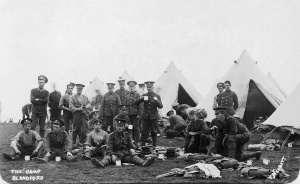
Men of the 2nd Battalion, Royal Munster Fusiliers, take a break while sorting kit at Blandford Camp, England, September 1910. (Imperial War Museum)
At Mons, however, the BEF did little more than delay the German advance. Fearing encirclement and annihilation, the Anglo-Irish commander of the BEF, Sir John French, ordered a general withdrawal. To expedite the so-called ‘Great Retreat’, the BEF split into its two constituent corps, both of which fought multiple rearguard actions. At the tail end of First Corps, for instance, some 250 men of 2/Connaught Rangers found themselves in the village of Grand-Fayt. Fighting their way westwards on 25 August, the Rangers lost more than 100 casualties. That night the exhausted remainder fell upon an abandoned ration dump in the unoccupied village of Maroilles; distracted by this bounty, they were surrounded and captured the following morning. Yet in comparison with 2/Munster Fusiliers, the Rangers had escaped lightly. Faced with the lead elements of two German divisions, the Munsters deflected several assaults, including an attack in which the Germans drove cattle in front of them as cover. By early afternoon on 27 August, however, they too had lost contact with the main body of First Corps. Retiring by companies across the Sambre L’Oise Canal, the Munsters staggered into the village of Etreux, where they discovered that flanking German infantry had already occupied the vacated British trenches. Ambushed from this unexpected quarter, the survivors diverted into a nearby cherry orchard. Here they made a heroic last stand, withstanding six attacking battalions until their ammunition ran out.
For their part, the Irish battalions of Second Corps—particularly 2/Irish Rifles, who again occupied the centre of the British line—distinguished themselves in the bloody Battle of Le Cateau (26 August). On this occasion, only the timely arrival of large-scale reinforcements, including battalions of Dublin, Inniskilling and Irish Fusiliers, all of which detrained at the chaotic battlefront, saved Second Corps from complete destruction. Of these fresh units, the Dublins made a particular impression because of their musical prowess. In between German infantry assaults, the ‘Blue Caps’ apparently confounded the enemy (and their officers) by indulging in nationalist and rebel anthems.
Battle of the Marne and advance to the Aisne
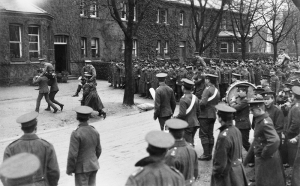
Carrying the officers who led them to victory in the Connaught Shield shooting competition at Aldershot, April 1914. Unfortunately for them, when it came to the real thing at Étreux, Picardy, on 27 August they ran out of ammunition and were almost wiped out in a heroic last stand. (Imperial War Museum)
Desperate holding actions like Etreux and Le Cateau enabled the BEF to escape and regroup. Meanwhile, the key battle of 1914, the Battle of the Marne, erupted to the east of Paris. Involving more than 2,000,000 men and 6,000 heavy guns, this titanic struggle soon spread across a wide front from the Ourcq River to Verdun. Performing a volte-face, the exhausted BEF joined the fray on 7 September. By then, French heroics and poor German leadership had opened a 30km gap in the enemy line. Advancing alongside the French, the BEF occupied and widened this breach, thereby threatening to en-circle multiple German divisions. Facing disaster, the soon-to-be-sacked German commander, Helmuth von Moltke, elected to retreat.
Yet if the Allies had achieved a war-defining operational victory, the retreating Germans now demonstrated that they too could perform dexterous rearguard actions. During this phase of the fighting, the Irish Guards distinguished themselves once more. On 8 September the Guards moved up to the Petit Morin, a tributary of the Marne. The Irish line of advance was, however, covered on the left by a wooded hill on which the Germans had sited several machine-guns. Advancing during a downpour and silhouetted by lightning, the Guards were badly mauled. With men ‘dropping on all sides’, they nevertheless turned and charged the enemy. Leading the assault was one Corporal J.J. Cunningham, who sported a large green flag embellished with a golden harp and the words ‘Eire go brath’ [sic]. Purchased by Cunningham on the day the Irish Guards left London for France, this flag became a cherished talisman of the regiment. In the event, Cunningham and his comrades survived the dash across open ground before subduing the German position with bayonets.
The ‘race to the sea’
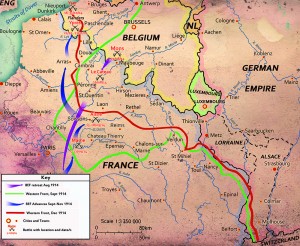 By the end of September the fighting on the Aisne had reached a stalemate. To break the deadlock, the competing armies now embarked upon the so-called ‘Race to the sea’. Fighting northward towards the Channel, each side desperately tried to turn the flank of the other. Equally matched, neither proved capable of a decisive breakthrough. After each clash, moreover, the troops resorted to their entrenching tools, thereby creating a continuous front that rapidly progressed through Artois, Picardy and Flanders.
By the end of September the fighting on the Aisne had reached a stalemate. To break the deadlock, the competing armies now embarked upon the so-called ‘Race to the sea’. Fighting northward towards the Channel, each side desperately tried to turn the flank of the other. Equally matched, neither proved capable of a decisive breakthrough. After each clash, moreover, the troops resorted to their entrenching tools, thereby creating a continuous front that rapidly progressed through Artois, Picardy and Flanders.
As the ‘race’ reached a climax, the Allies struggled to contain two fresh German armies that advanced from Antwerp (which fell on 9 October) and Lille. At this juncture, 2/Leinsters learned a harsh lesson about battlefield communications. Entrenched in the village of Prémesques, the Leinsters had outstripped the other battalions in their brigade. Crucially, they were also too far forward to receive artillery support. Consequently, the battalion spent Sunday 18 October under constant bombardment without the means to reply. The next day was eerily quiet. For their part, the Irish took advantage of this reprieve to treat their wounded and prepare breastworks and additional defences. Early on the morning of 20 October, a reinforced Saxon regiment descended upon the village. When the Saxons drove in their forward pickets, the Leinsters withdrew to the south, where they rallied under the direction of a quick-thinking Major Mather. Anchoring a makeshift line on an impenetrable wood to the east, Mather concentrated every available man against the advancing German right. Risky though it was, this oblique manoeuvre bought sufficient time to reposition the battalion machine-guns, which in turn checked several German attempts to push on from Prémesques. Remarkably, the Leinsters were not the only Irish battalion to court disaster on 20 October. In a parallel assault on Le Pilly, 2/Royal Irish Regiment had likewise outstripped their supporting units. Two Westphalian regiments spotted this mistake and quickly surrounded the village. By midday the Irish machine-guns had been knocked out by accurate shellfire, and by late afternoon the defenders were down to a few cartridges each. When the Irish fire had all but ceased, the Westphalians rushed the village from multiple directions. Severe hand-to-hand fighting followed, but the outcome was never in doubt. In total, the defenders suffered 400 casualties—most of them recently arrived drafts from Clonmel—whilst a further 300 men were marched into captivity. At nearby Neuve Chapelle, meanwhile, the hard-fought 2/Irish Rifles again found themselves in an impossible situation. Occupying ill-prepared trenchworks on 22 October, the Ulstermen withstood severe bombardments and nocturnal infantry attacks, some of which were only repulsed at the point of the bayonet. The attackers (inexperienced Bavarian conscripts) suffered heavy losses. According to one unsentimental Irish rifleman, they ‘fell in scores, in hundreds, the marching columns wilting under our rapid fire … The few survivors panicked, and tried to keep their feet in retreat. We shot them through the back.’ Even so, the defence of Neuve Chapelle was a lost cause, and by the time the Germans ejected the Irish from the village they numbered less than 200 men. Although a series of drafts from Belfast replenished these losses, these men likewise succumbed in fierce fighting near Hooge, which lay further east along the Menin Road. Indeed, when the Rifles finally withdrew to the rear on 19 November, only 40 men presented at the battalion muster.
First Battle of Ypres
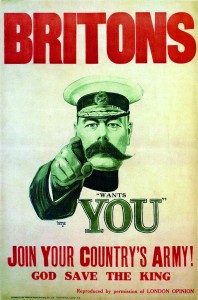
The instantly recognisable secretary for war, Field Marshal Herbert Horatio Kitchener, hailed from Ballylongford, Co. Kerry. With the original BEF effectively obliterated by the end of 1914, Lord Kitchener and the War Office would henceforth have to rely upon the ‘New Army’ amateurs then in training across the United Kingdom.
Eventually, the British and French found themselves desperately defending a precarious salient that extended eastward from the medieval city of Ypres. This epic struggle culminated in two major German offensives, the first of which fell upon the outlying town of Gheluvelt. On 29 October six Bavarian divisions, scrutinised by the Kaiser himself, launched an all-out attack on the hamlet. Suitably inspired, the Bavarians almost punched a hole through the British lines. In fact, only the determined leadership of an Irishman, Brigadier Charles FitzClarence (VC), prevented collapse and rout. From Bishopscourt, Co. Kildare, FitzClarence commanded the élite Guards Brigade. Moreover, because an enemy shell had obliterated the British battle HQ, he was the senior surviving officer at the point of the German breakthrough. Marshalling a scratch force, FitzClarence routed the 16th Bavarian Reserve Infantry Regiment (the unit of an obscure private named Adolf Hitler) at Château Gheluvelt, in the process sealing the potentially fatal breach in the British lines. Remarkably, FitzClarence remains one of the war’s lesser-known Irish actors, even though a grateful Lord French later implied that by his actions he had saved Ypres, and with it the Channel ports that kept the BEF alive.
Even so, the situation around Gheluvelt remained critical. For their part, the Irish Guards held trenches east of Zillebeke Wood against sup-erior forces. Driven back to the tree line by heavy shelling and machine-gun fire, ‘the Micks’ readied themselves for a last stand. As explained by the regimental historian, Rudyard Kipling, at this point ‘the officers, every cook, orderly and man who could stand, took rifle and fought’. Reduced to tatters, the Guards held out, but at a terrible cost. By the end of the action, total casualties—including 88 men killed in a single trench completely blown in by shellfire—surpassed 600 men. Elsewhere, 2/Inniskilling Fusiliers distinguished themselves at Douvre Farm, which lay to the west of the infamous Messines-Wytchaete Ridge. Acting on the direct orders of the Kaiser, the renowned German Guards cavalry stormed Douvre on 31 October. Here they ran into a devastating Irish crossfire, for the Inniskillings, who were rightly renowned for battlefield cunning, had discreetly enfiladed the complex the previous night.
Yet Moltke’s successor, Field Marshal Eric von Falkenhayn, regarded Gheluvelt as a setback, not a defeat. Intent upon capturing Ypres before the full onset of winter, he launched one last attack on 11 November. On this occasion the Germans threw twelve divisions against the salient. Moreover, the most intense artillery bombardment yet seen in the war preceded the great attack. Although this barrage was largely ineffective, it clearly inspired the imperious Prussian Guards, who, massing at their jump-off points, indulged in rousing renditions of the ‘Watch on the Rhine’ and other battle anthems. Masked by heavy rain, smoke and fog, the Germans began their advance at 09.00hrs. Initially the poor visibility enabled them to close upon their objectives without heavy losses. When they eventually emerged from the mist, however, the dense ranks of grenadiers again lost heavily to waiting British infantry. Indeed, over the course of the morning, expert musketry and relentless machine-gun fire effectively destroyed the flower of the German Army. Several Irish battalions participated in the slaughter. For instance, as part of a scratch force strung out in front of Herenthage Chateau, the remnants of the Irish Rifles found themselves facing the van of 3/Prussian Division. As at the Aisne, some of the Rifles’ half-trained draftees froze, on this occasion fumbling and misfiring mud-covered, poorly oiled and rain-soaked weapons. Inspired by a larger-than-life regimental sergeant-major named John Kearns, the novices eventually recovered their nerve and held the line. To the left of Herenthage Chateau, meanwhile, elements of 4/Prussian Division locked horns with 2/Royal Munster Fusiliers, which had been resurrected with reservists from the regimental depot in Tralee. Operating in groups of two or three, and aware that there was no support to the rear, these hitherto unrated troops likewise fought with abandon—as the regimental history put it, ‘they gritted their teeth and prepared to “die hard”’. For their part, the Prussians lived up to their reputation. Scourged by air-bursting shrapnel and repeatedly broken by rifle fire, they doggedly persisted, reforming time and again and coming on, as one witness put it, ‘in a sort of dazed way, as if they were drugged’. Such reckless courage was to no avail. By 09.45hrs the Munsters had blunted the attack on their front, winning a famous victory afterward retold by Cork children, who sang of how ‘The Kaiser Bill tried very hard/When he lined our front with the Prussian Guard/But the brave Old Munsters still fought hard/And held them back at Ypres’.
After 11 November the Germans made no further attempt to break through to the Channel coast. Instead, Field Marshal von Falkenhayn turned his attention to the struggling Russians, whom he expected to crush in 1915. Even so, by Christmas 1914 the Western Front had claimed c. 1,600,000 casualties (killed, wounded and missing), a figure that would not be matched in any other comparable period of the war. The proportional cost to the British Army was particularly high. At Ypres alone the BEF lost 58,000 men, whilst total British losses for 1914, including a conservative estimate of 8,000 Irishmen, exceeded 85,000. These figures should be understood in the context of an original British complement of 80,000 combatants, who were steadily supplemented by a further 100,000 men drawn from reservists and the imperial army. With the original BEF effectively obliterated, Lord Kitchener and the War Office would henceforth have to rely upon the ‘New Army’ amateurs then in training across the United Kingdom.
Mark Phelan’s Wherever the firing line extends: Ireland and the Great War, 1914–18 will be published in 2015 by Collins Press.
Read More:Localised successes at Mons
Battle of the Aisne
Further reading
A. Conan Doyle, The British campaign in France and Flanders, 1914 (London, 1920).
J.E. Edmonds, Military operations: France and Belgium, 1914 (2 vols, London, 1925).
T. Johnstone, Orange, green and khaki: the story of the Irish regiments in the Great War (Dublin, 2005).
R. Kipling, The Irish Guards in the Great War: Volume I, The First Battalion (London, 1923).
















